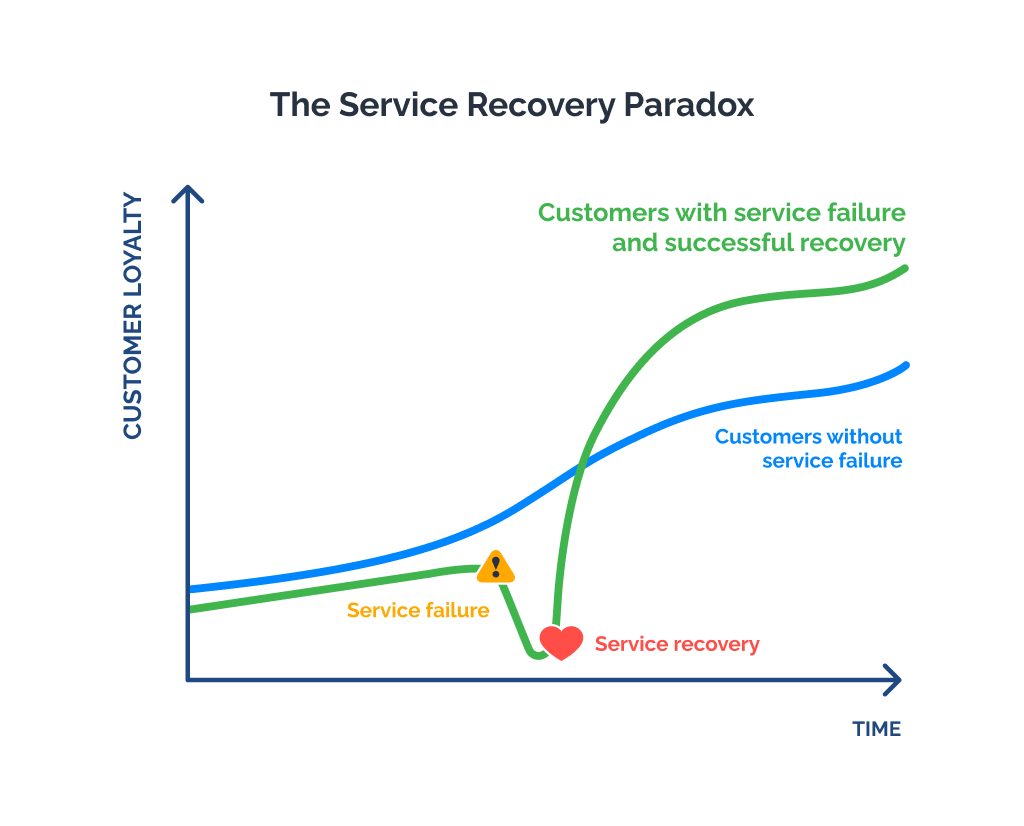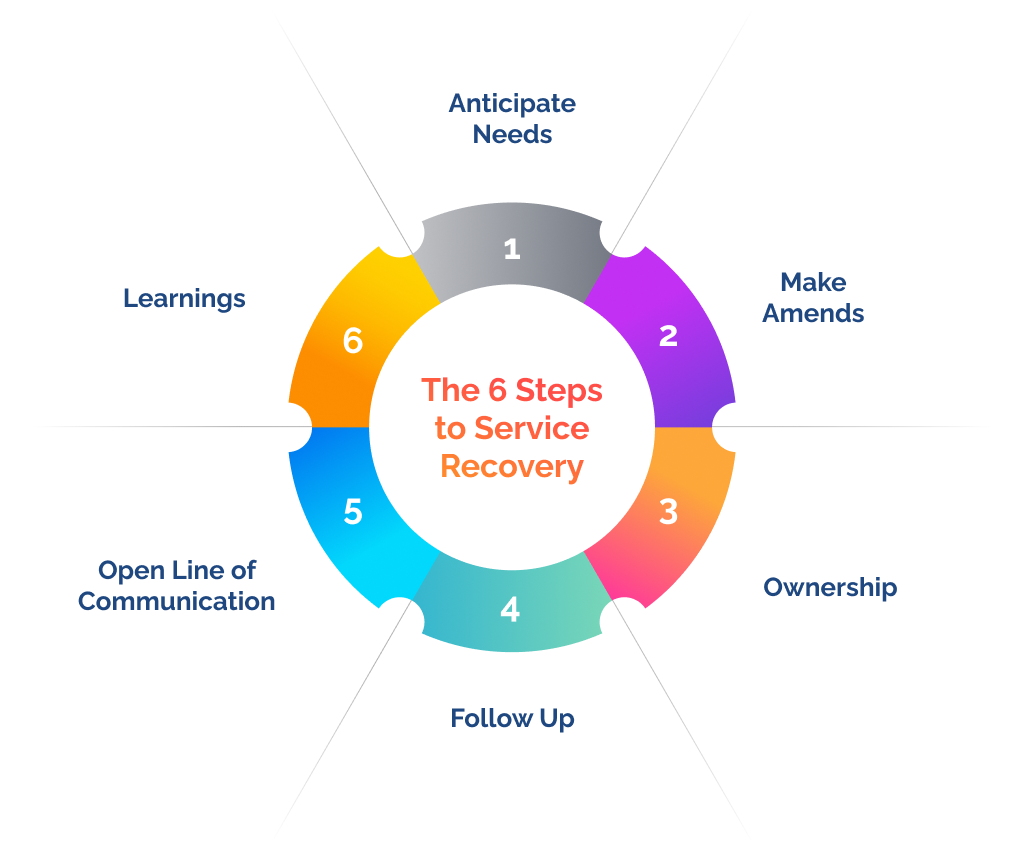The “Service Recovery Paradox” (SRP) is a concept in customer service that suggests a customer’s loyalty to a company can increase after a service failure, provided the company effectively resolves the issue. The paradox occurs when a customer’s post-recovery satisfaction exceeds their satisfaction level before the service failure. This effect hinges on the company’s ability to respond quickly, empathetically, and effectively to resolve the problem, often exceeding customer expectations in the process. However, it’s important to note that this paradox doesn’t apply to all situations and repeated failures can lead to a loss of trust and loyalty.
Looking to optimize your referral program?
Check out our Ultimate Guide to Customer Loyalty to maximize your strategy 🚀
The Dynamics of SRP in Building Loyalty
SRP hinges on the surprising outcome of a service mishap, where a company’s response not only rectifies the issue but also leaves a positive, lasting impression. This enhanced satisfaction post-recovery can translate into stronger customer loyalty. For instance, when a customer’s complaint is met with not just a resolution but an unexpected upgrade or personalized service, their perception of the company improves, often leading to a stronger emotional connection and commitment to the brand.
 Exceeding customer expectations after a service failure can lead to heightened brand loyalty
Exceeding customer expectations after a service failure can lead to heightened brand loyalty
Real-Life Impacts on Loyalty
Imagine a scenario in a retail setting where a customer faces an issue with a product. If the store not only replaces the product but also offers a future discount, the customer’s disappointment is not just alleviated; their loyalty towards the store is likely to increase. Similarly, in the service industry, such as hospitality or airlines, how complaints are handled can transform a dissatisfied customer into a loyal advocate, provided the recovery exceeds their expectations.
Key Factors in SRP’s Influence on Loyalty
The effectiveness of service recovery in fostering loyalty depends on several factors. The magnitude of the service failure, the speed and empathy of the response, and the perceived value of the compensation are critical. Minor service failures resolved exceptionally well are prime scenarios for SRP, leading to enhanced customer loyalty. The communication style during the recovery process also significantly affects customer loyalty, with transparent, empathetic, and proactive communication being the most effective.
The Service Recovery Process
The process of service recovery is essential for businesses looking to turn service failures into opportunities for enhancing customer loyalty and satisfaction. The steps involved in an effective service recovery program are generally as follows:
Anticipate and Understand Customer Needs: This step involves researching and understanding customer expectations. It’s crucial to align your services with these expectations and be realistic about what you can deliver. Tools like the SERVQUAL Instrument can be used to measure and improve service quality in line with customer needs.
Making Amends: When a service failure occurs, it’s important to rectify the situation in a way that is perceived as fair by the customer. This might include apologies, compensation, or other gestures of goodwill. Empowering frontline staff to make decisions that allow for quick and effective recovery is vital.
Empowerment and Ownership: Employees should be encouraged and enabled to take control of service recovery situations. This might involve financial allowances for customer compensation or simply entrusting them with the authority to make decisions that can swiftly resolve customer issues.
Respond Promptly and Follow Up: Quick response to service failures is crucial. After resolving the issue, follow up with the customer to ensure their satisfaction and inform them about any internal changes made to prevent future service failures.
Keep an Open Line of Communication: Encourage feedback from customers. This helps in identifying silent dissatisfied customers and addressing their concerns proactively.

Turn negative experiences into opportunities by using the Service Recovery Wheel
Each of these steps plays a crucial role in transforming a negative customer experience into a positive one, thus enhancing customer loyalty and trust in the brand. After each service recovery, it is important to learn from the issue and close the loop by taking the necessary actions for a more fail-proof service in the future.
The Limitations in Reliance on SRP
While SRP can lead to increased loyalty, it’s crucial to note its limitations. Frequent failures, even with excellent recovery, can erode trust. Moreover, in cases of major service failures, achieving SRP and consequently boosting loyalty is more challenging. Therefore, consistent high-quality service should always be the primary aim.
Strategies for Maximizing Loyalty through SRP
To harness SRP for boosting customer loyalty, businesses should focus on understanding customer expectations and tailoring their recovery efforts accordingly. Going beyond the conventional resolution and surprising customers with additional value can significantly enhance their loyalty. Training staff to handle service recovery empathetically and effectively is also vital.
Implementing the Service Recovery Paradox in Your Business Strategy
To harness the benefits of the service recovery paradox, businesses must implement a structured approach to resolving customer issues. Start by empowering employees to address problems swiftly and effectively, ensuring they have the tools and authority to make decisions that exceed customer expectations. Additionally, tracking customer feedback post-recovery is crucial, as it helps in fine-tuning your approach and understanding how recovery efforts are perceived. By continuously improving your service recovery processes, you can transform potential losses into opportunities for strengthening customer loyalty.
Measuring the Impact of Service Recovery on Customer Loyalty
Evaluating the effectiveness of your service recovery efforts is key to maximizing the benefits of the service recovery paradox. Utilize customer satisfaction surveys and net promoter scores (NPS) to gauge customer sentiment after a service recovery. Monitoring repeat purchase rates and customer retention metrics can also provide insights into how well your recovery strategies are converting dissatisfied customers into loyal advocates. By analyzing these metrics, businesses can refine their recovery processes and consistently enhance customer loyalty.
Conclusion
The Service Recovery Paradox presents not just a challenge but an opportunity in the landscape of customer service. It underscores the potential for businesses to transform service failures into loyalty-building moments. By strategically employing SRP, companies can turn negative experiences into positive outcomes, ultimately strengthening their relationship with their customers and enhancing long-term loyalty.
Unlock growth with referrals—request your free Ambassador demo today and see the impact firsthand!
Got Questions?
Let’s Talk About Your Referral Strategy
